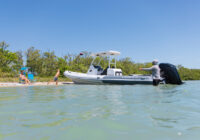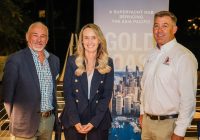Get away from it all in a place where nature rules… The glorious Fiordland National Park in New Zealand and the way to do it is on board the Fiordland Jewel by Helen Hayes.
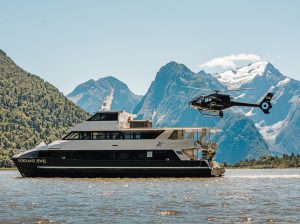
I stop paddling and look around. There is no town, no infrastructure, no people, except for those who are on the same adventure as me. There is only nature, as far as the eye can see. Rock cliffs arc up out of the glacier-cut fiord, hardy trees clinging to the vertiginous granite face with a tenacity to behold. Tangles of beech, southern rata and rimu come right down to the waterline, the rata flowering red and attracting flocks of gossiping kākā. The cliff face also has vast patches of olive coloured moss, that sucks in some of the water that cascades down after the frequent rain. It is so serene and achingly beautiful. I feel like I have boarded Dr Who’s TARDIS and gone back a few thousand years. Perhaps to Middle Earth. My reverie is broken by a cry that there is a seal up ahead so I resume paddling to catch up with my shipmates in the here and now. Nature really is calling.
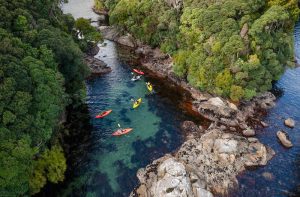
I am cruising the magical waters of Fiordland National Park with Fiordland Discovery on board Fiordland Jewel, a 24-metre, three-deck catamaran that was purpose-built in New Zealand for Fiordland waters. It is owned and operated by the Swale family, who have been cruising these waters for generations. On this six-night adventure, we will venture up narrow arms of pristine fiords, anchoring in tranquil, mirror-smooth coves protected by the rugged cliffs that rise and fall in myriad waves up into the misty distance. Māori used to call this place Ata Whenua, the Shadowlands, and it is into the shadows we cruise…
Fascinating Fiordland
The largest national park in New Zealand, Fiordland covers a whopping 1.2 million hectares and ranges from Martins Bay in the north to Preservation Inlet in the south. Part of the Te Wahipounamu World Heritage site, it is the last representation of Gondwanaland, giving us a sense of what it was like millions of years ago. There are 14 fiords, running like watery veins up to 40 kilometres inland. Milford Sound/Piopiotahi is the most accessible, but even then, it is not easy. But that is definitely part of the allure. Fiordland is far, far away from it all, and its southerly fiords are so beautiful they’ll render you speechless.
My journey starts in Queenstown, where I am picked up by a luxury van for the drive to Manapouri, whisked by boat to Manapouri Power Station, and then bussed over Wilmot Pass to Deep Cove, where our aquatic chariot is waiting. We sail out into Doubtful Sound/Patea full of anticipation. We settle into our cabins, check out the vessel and meet the crew, who look after us in fine style on our adventure. I am in a Captain Cook cabin, with a super king-size bed and large picture windows. The bathroom is roomy and the shower is better than most five-star hotels. There are plenty of hooks around the cabin, lots of lockable storage – not for security, but for when the vessel goes down the coast. After unpacking, it’s up to the lounge, a cosy and comfortable space with tables for all meals, and couches that are perfect for reading one of the reference books about the area, reading the latest novel or napping.
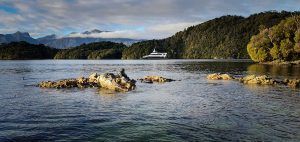
Exploring Southern Fiordland
Skipper Jimmy Mackay lets us know that we will be anchoring in Crooked Arm, and on the way to this peaceful spot we are immersed in scenic overload. Peak after peak, waterfall after waterfall, gobsmacking beauty everywhere. Chef Lucas Kaminski Sampaio conjures up his first act of sorcery with an incredible two-course dinner. He wows us all each and every night with his skill and his flavours. Our host Cindy Chaussaud, who hails from Paris, is a delight with her sunny nature, and cannot do enough for us all. And deckhand Jack Swale runs us in and out from the shore in the tender, and assists all around the boat with grace. After a long travelling day, I am happy to fall into my very comfy bed, leaving the remote controlled blinds up so I can see the view when I wake. I think I am still dreaming when I open my eyes to ghostly apparitions and dangly white ribbons out the cabin window. Rubbing my eyes I see the ghosts are in fact rocky peaks shrouded in mist and backlit by the struggling dawn, and the ribbons are actually waterfalls. It is mesmerising and it matters not that it is raining. It adds to the moody mystery of this ancient land.
Going coastal
Jimmy warned us all about the fact that the three-hour run down the coast from Doubtful Sound/Patea to Dusky Sound/Tamatea would be unpleasant, with everything locked down. After cruising past the Fill ‘Ya Cup Falls (where Jimmy noses the boat so close that you can fill your cup) we check out the Blanket Bay Hotel, a famous crayfishing shack used by many Fiordland lovers – including Jack’s father and grandfather – Jacques Cousteau even came to visit. We squeeze through The Gut and finally turn to port into the Tasman Sea when out past the Hares Ears rocks. Conditions are rough, with a very confused seaway, a swell topping three metres and a following wind of around 20 knots. Those of us who are not green about the gills are entertained by the beautiful seabirds elegantly gliding along on the wind beside our rocking and rolling cat. There are giant petrels, Buller’s albatross, the pretty black and white cape pigeons, wandering albatross, white-capped albatross and the spectacular royal albatross, which has a wingspan of three metres. We are all thankful to reach Breaksea Island and head alongside Resolution Island into Dusky Sound/Tamatea, which is much calmer. We head down Acheron Passage and then into Wet Jacket Arm, a spectacular narrow fiord flanked by cliffs. We anchor for the night at the end of the Arm, well protected and mesmerised by the view.
Divine Dusky
Dusky Sound has 365 islands and there are many hidey holes to tuck up into. Extending over 55km, it is home to pods of bottlenose dolphins, and has colonies of New Zealand fur seals, along with Crested Fiordland Penguins and an array of birdlife from kākā to weka, saddleback, bellbirds, tomtits and robins. While in Wet Jacket Arm we experience the first of many shore visits, taking a walk to what’s known as the ‘Avatar’ Tree. With Fiordland known for its temperate rainforest, it is no surprise that everything is wet. Really wet. We pick our way through muddy puddles that suck at your shoes and splash through newly formed streams, all the while admiring the beautiful forest with its fabulous Jurassic-like foliage. The tree is worth the walk, a weird and wonderful beech tree that does have a touch of ‘Avatar’ about it. Back on the boat, we tuck into lunch and some of us join the skipper for a cold plunge into the 7 degree water – brrrrrr – but I practically levitate up the ladder and straight to the rooftop hot tub. Another trip to shore saw us walking to Supper Cove Hut, a rustic cabin at the head of Dusky Sound. There are watery adventures too, and we enjoy having a ‘shower’ under waterfalls, giggling like schoolkids under the icy spray on the bow of the boat. The next anchorage, Sportsman Cove, is a secret gem, accessed through a tiny gap at the end of Cooper Island. It is heavenly, and we paddle around in kayaks or mosey in the tender to explore. It was here that some fascinating boat races happened back in 1773. Read on to find out who.
We also go ashore at Astronomers Point in Pickersgill Harbour, where Captain James Cook stopped to repair his boat (Resolution) after months in the Southern Ocean near Antarctica. He had seen the entrance to Dusky Sound in 1770, and when he was looking for somewhere to go, he remembered Dusky, and incredibly, managed to sail back to it. They ran the ship onto a pebbly bottomed cove, so they could clear the hull of barnacles, set up a forge, a brewery – the beer was made using rimu and manuka that kept scurvy at bay – and carried out repairs. They used a rimu tree branch as a gangway, and incredibly, it is still there. Astronomer William Wales was tasked with fixing the position of New Zealand, and we can see the trees felled to allow for his observatory to be constructed. Wales gave such an accurate reading of longitude and latitude that when checked centuries later using modern equipment, it was just 1 cm off. You can see a peg marking this spot.
Cook was a busy man while here. He meticulously charted Dusky Sound and made copious logbook entries and notes. He was involved in the first peaceful meeting between Europeans and Māori at a place Cook called Indian Island. We see the very spot this happened. We learn the subsequent interactions were very friendly, and Cook and the Māori chiefs exchanged gifts showing their mutual respect. One day, Cook’s men rowed the longboats around to a pretty cove and had races. When we were in that very cove, named Sportsman Cove by Cook, it was easy to imagine the longboats coming in through the entrance, and spine tingling to know that it hasn’t changed since then. Cook’s artist on board, William Hodges, painted a lot of these scenes, including the interactions between Cook and the Māori. He also painted perhaps the most beautiful waterfall in the region, Nine Fathoms, which is like something out of a Disney movie. It is magnificent.
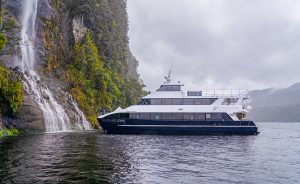
Down to Preservation InletExploring Southern Fiordland
We face another ocean passage from Dusky Sound to Preservation Inlet, but the weather is much more pleasant, with glassy seas, a sighting of humpback whales, and albatross accompanying us once again. We even manage to go fishing in the Tasman. Fiordland Jewel is well set up for fishos, and we helped bolster the chef’s stores by catching multiple blue cod, and tarahiki. The rods have Shimano electric reels, braided nylon line and heavy sinkers. Crayfish are also picked up along the way from craypots, meaning very happy and well-fed campers once we are safely anchored in Isthmus Sound, deep in Preservation Inlet. On our last full day, I fish for blue cod, go ashore at Kisbee Lodge, where there was once a thriving gold mining settlement called Cromarty, walking through muddy, pristine bush to see the old steam turbine left behind. We go ashore to hike to Puysegur Point Lighthouse and go for a last explore around Revolver Bay in a kayak or in the tender. I paddle slowly, soaking up the magnitude of this place, and not wanting this experience on Fiordland Jewel to end. When I fly off the boat in the helicopter back to Te Anau, I watch nose-to-window until it, like the landscape, melts back into the Shadowland.
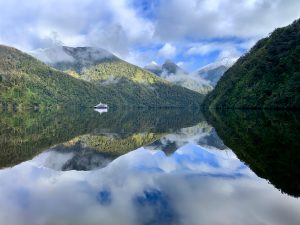
Fiordland Discovery
Owned by Fiordland Discovery, Fiordland Jewel is a three-deck vessel designed and built by Fiordland Discovery owner, Rob Swale. Fiordland Jewel conducts the six-night Southern Fiords itinerary, a longer nine-night itinerary that includes Milford Sound, and overnight and (new) lunch cruises in Milford Sound from November to April. There are nine cabins catering to 18 guests on the longer itineraries, and up to 22 on the Milford Sound overnights. Guests on the six-night itinerary will fly one way by helicopter between the ship and Te Anau, and will be transferred from Manipouri to Deep Cove for the other leg. Tip: Take wet weather gear, layers of clothing and waterproof hiking boots.
Visit fiordlanddiscovery.co.nz
Where to stay – Hulbert House
It is recommended that you stay in Queenstown for the night before and after your cruise. I stay at the elegant Hulbert House, a stunning historic house that dates back to 1888. Situated a five-minute walk from the centre of town, this elegant Victorian beauty has been lovingly restored with the interior design by Neil McLachlan, and has the perfect balance between olde-world splendour and modern comforts. There are six beautiful rooms, four downstairs and two lovely loft rooms upstairs. All are named after someone from the House’s past. I am in the Firth Suite, a delight in purple, royal blue and gold, with views out over Lake Wakatipu and to The Remarkables. The bed is dreamy with top notch luxurious linen, the bathroom is big and features striking tiles and the writing desk well positioned to see out the window. The Palm House lounge area, with its stunning French antiques and chandeliers, is the spot to sit and relax by the fire, and enjoy pre-dinner drinks and canapés before heading out to dinner in one of Queenstown’s excellent restaurants.
Visit hulberthouse.co.nz
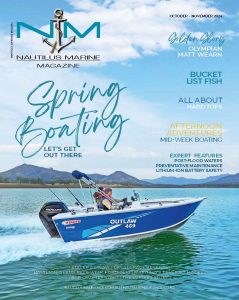
The October-November issue of Nautilus Marine Magazine is out now.
About Nautilus Marine Magazine
Nautilus Marine Magazine offers readers 100 pages of content to support their on-water lifestyle. Published every two months across Australia and New Zealand for an audience of Nautilus Marine Insurance customers, members of the marine industry and boating enthusiasts, our magazine features expert features, boat profiles, interviews with boating and sailing identities, fishing adventures, travel destinations, boating lifestyle content and dining. No matter what side of the boating spectrum you sit on, power or sail, Nautilus Marine Magazine is a must read.
About Nautilus Marine Insurance
Nautilus Marine Insurance is a leading provider of insurance solutions for recreational vessels and marine business assets across Australia and New Zealand, protecting over 45,000 vessel owners and marine industry members. For over 19 years, Nautilus Marine Insurance has been a specialist supplier of insurance for pleasure craft and marine business assets and liability insurance. Nautilus Marine Insurance provide coverage for pleasure craft of all sizes, ranging from sailing dinghies and personal watercraft (PWCs) through to yachts, runabouts, and luxury motor yachts as well as commercially operated boats and marine businesses. Through its Industry Lines division, Nautilus Marine Insurance also specialises in providing tailored business insurance for clients servicing the recreational boating market including marina operators and owners, yacht clubs and boat clubs, boat dealerships and most marine trades including boat repairers and boat service providers. Thousands of professional insurance advisers and brokers choose to work with Nautilus Marine Insurance. These insurance experts trust the breadth of Nautilus Marine’s products and claims support to recommend our products and services to their clients. Nautilus Marine Insurance has a passionate team of over 90 staff and offices across Australia and New Zealand. Nautilus Marine Insurance is a business name of NM Insurance Pty Ltd, ABN 34 100 633 038, AFSL 227186. It has binding authority from Zurich Australian Insurance Limited (ZAIL) which allows it to enter into and arrange policies of insurance and handle and settle claims made under them. Visit nautilusinsurance.com.au to find out more.









